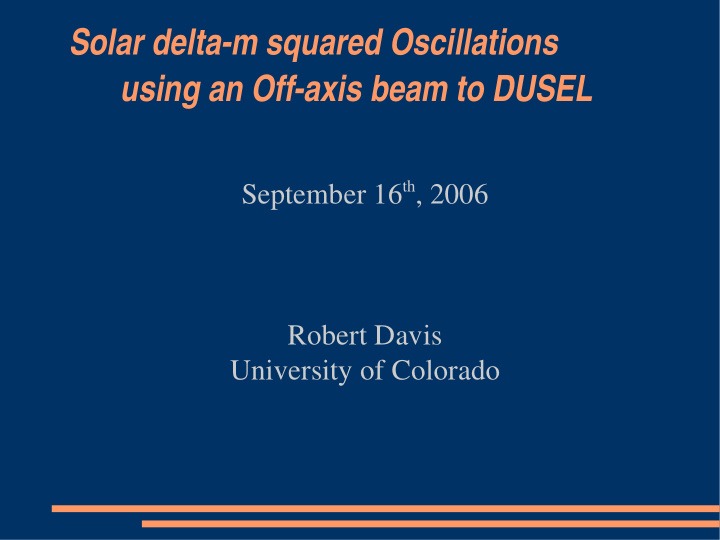



Solar delta-m squared Oscillations using an Off-axis beam to DUSEL September 16 th , 2006 Robert Davis University of Colorado
Goals ● Perform first terrestrial measurement of solar parameters using neutrinos (not anti-neutrinos) – By use of Long Baseline Accelerator Experiment ● Can you improve the delta-m 2 measurement beyond current understanding? ● Develop sensitivity to theta23 octant
Considerations ● Use off axis flux to isolate lower energies ● Looking for an effect that is at lower energy than delta m 2 23 ● See if it is possible to distinguish between theta12 and theta13
Physical Equation P( υ µ −> υ e ) = sin 2 (2 θ 12 )∗ sin 2 ( m 2 21 L/(4E))*cos 2 ( θ 23 ) m 2 21 L/(4E) << 1 P( υ µ −> υ e ) ≈ sin 2 (2 θ 12 )∗ ( m 2 21 L/(4E)) 2 *cos 2 ( θ 23 ) Therefore plot: cos 2 ( θ 23 ) vs sin 2 (2 θ 12 )∗ ( m 2 21 L/(4E)) 2
Method ● Modified T2K Monte Carlo used for beam flux – Geant 3 ● GLOBES program used to calculate event spectra – Will be used in the future to calculate sensitivities ● Construct sensitivity plots
Experiment Assumptions ● 2 º Off Axis ● Baseline 1497km (FNAL to Henderson) ● Detector 300 kTon Water Cherenkov – Performance modeled on existing SuperK ● 0.77 MW Oscillation Parameters used: ● 5 year running time sin 2 (2 θ 12 ) = 0.8 ● 40 Gev beam sin 2 (2 θ 23 ) = 1 m 2 21 = 7e-5 eV 2 m 2 31 = 2e-3 eV 2 cp = 0
2 º Off Axis Beam Comparison at 1497km ● J-PARC flux optimized for ½ to 1 GeV energies with small e and 0 backgrounds ● Taken as a starting point, other fluxes will be examined (No Oscillations)
2 º Off Axis Beam Comparison 0 to 2 GeV window
Nue Appearance Event Spectra ● sin 2 ( 2θ 13 ) = 0.1 (red) – Total Events 17 ● sin 2 ( 2θ 13 ) = 0.0 (black) – Total Events 10 Signal Experimental Parameters ● – 2 º Off Axis – Baseline 1497km – Detector 300 kTon Water Cherenkov – 0.77 MW – 5 year running time Background – 40 Gev beam
Conclusions ● There are effects of the solar parameters at this distance ● Statistics are too low to look at sensitivities – Based on extremely conservative estimate of background rejection, efficiency and beam flux – Need to look at higher fluxes and variations of detector parameters
Near Future ● Use WBLE flux at 1497km and 2 º off axis to examine solar parameters ● Include some of the new detector designs to get more events ● Look at different off axis angles – For example: 0.75 º , 1 º , 1.5 º ● Generate sensitivity plots for the solar parameters and cos( θ 23 ) – For example plot: 21 *sin 2 ( 2θ 12 )) 2 vs sin 2 ( 2θ 13 ) ( m 2
Recommend
More recommend